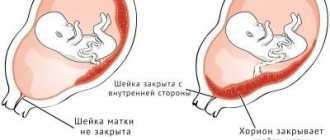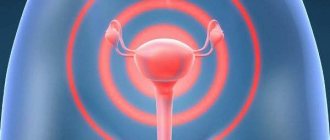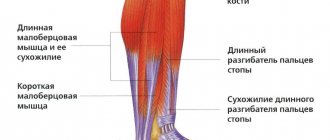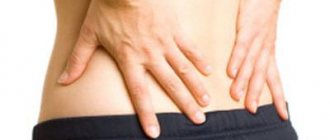Causes of tone
Since the uterus is a muscular organ, it cannot remain in a state of constant relaxation. Tension, even slight, is always present in the uterus. Moreover, if the tone is slightly increased in the area of contact between the wall and the embryo, this indicates that the latter is taking root well.
Minor inflammation may be caused by increased blood flow to that particular area. In this way, the mother’s body supplies the embryo with the substances necessary for its life and development. An ultrasound will characterize this area as edematous, which is understandable and is also considered tone during pregnancy.
The tone can be general, that is, it extends to the entire organ, or local. The latter is divided into hypertonicity along the posterior wall of the uterus and the same condition along the anterior wall.
The muscles of the reproductive organ can be tense for the following reasons:
- Uterine pathologies. These include endometriosis and fibroids. Hypertonicity of the posterior wall of the uterus and problems with bearing a child are closely related to the anatomical features of the uterus. It can be saddle-shaped, bicornuate, or have other structural features. Such anomalies can create difficulties in the process of bearing a child;
- Lack of progesterone. Usually triggered by underdevelopment of the genital organs or an abundance of male hormones (androgens);
- Viral infections. They significantly weaken the immune system, which does not have the best effect on the uterus. Infections are accompanied by symptoms such as itching and burning of the external genitalia, qualitative changes in discharge.
- Oligohydramnios or polyhydramnios. The abundance or lack of amniotic fluid equally negatively affects the muscle layer specifically of the posterior uterine wall;
- Stress. They have a detrimental effect on the body as a whole. They weaken the reserves of a pregnant woman’s body, causing the maca to strain unnecessarily;
- Stretching of the uterine muscles. Often occurs in the presence of multiple pregnancies or carrying a large fetus;
- Inflammation in the ovaries or uterus. Such processes can cause alternating tension and relaxation of the reproductive organ;
- Excessive physical activity. They make internal organs tense, the uterus is no exception. Lifting weights or excessive exercise does not have the best effect on the condition of the uterus.
- Different Rh factors in the blood of mother and fetus. In case of Rh conflict, the process of rejection of the fetus by the mother's body may begin. At this time, the tone of the reproductive organ increases significantly.
- Abortions performed by a woman before her current pregnancy can also cause hypertension. This also includes miscarriages and premature delivery.
- Changes in intestinal motility. The latter changes in size due to the accumulation of gases and puts pressure on the body of the uterus, causing tension in its muscles.
Symptoms of hypertension
Manifestations of increased contractility of the uterine muscles vary depending on the location of the tone. Based on this feature, there are three main forms of pathology:
In the second half of pregnancy, tone, localized both along the posterior and anterior walls of the uterus, may be accompanied by changes in fetal movements. Therefore, if a child begins to move much more often or, conversely, shows virtually no activity, this is a reason to consult a doctor.
Important! Symptoms of uterine hypertonicity are similar to so-called training contractions.
But, unlike pathologically increased tone, such contractions do not last long and do not cause severe pain.
Main features
One of the signs of hypertonicity is pain in the lumbar region
The phenomenon of uterine tone along the posterior wall can be asymptomatic. This pathology can often be diagnosed only after an ultrasound procedure. But sometimes the tone of the posterior wall of the uterus during pregnancy is accompanied by the following symptoms:
- pain in the lower abdomen (similar to menstrual pain);
- lower back pain;
- increased pain due to fatigue or physical overload;
- the reproductive organ is tense and seems to “turn to stone” (this condition most often accompanies the last trimester of pregnancy).
The presence of one or more of these symptoms may indicate the tone of the uterus along the posterior wall, in which case you should immediately consult a doctor. A particularly alarming sign is spotting or heavy vaginal bleeding. When they appear, the woman should immediately call an ambulance and try to calm down as much as possible. At this stage of medical development, doctors often manage to save a child in the womb.
Treatment and first aid
Treatment for uterine hypertonicity is necessary if there are alarming symptoms - pain and bleeding, as well as in cases where ultrasound reveals a threat of miscarriage, signs of placental insufficiency or dilation of the cervix.
To eliminate the pathological condition, pregnant women are recommended to go to the hospital. With moderately increased tone, outpatient treatment can be carried out, prescribed depending on the clinical picture. The following drugs are used:
If a pregnant woman experiences a feeling of uterine tension in the second and third trimester, the condition can be alleviated at home. To do this, you should get on all fours and perform this exercise several times - bend your lower back while raising your head (keep the pose for 5 seconds). This will relax the muscles of the uterus. Then you need to lie down to rest, taking a comfortable position (preferably on your side).
Review from our reader Svetlana Afanasyeva
I recently read an article that talks about Father George’s Monastic Collection for the treatment and prevention of fibroids. With the help of this collection you can FOREVER get rid of fibroids and problems like women at home.
I’m not used to trusting any information, but I decided to check and ordered a bag. I noticed changes literally within a week: the constant pain in the lower abdomen that had tormented me before receded, and after 3 weeks disappeared completely. Uterine bleeding has stopped. Try it too, and if anyone is interested, below is the link to the article.
Important! The described actions do not eliminate the need to seek medical help.
How to diagnose hypertension?
It is possible to confirm or refute the presence of hypertonicity along the posterior wall of the uterus by undergoing an ultrasound. This procedure will provide detailed information about the condition of the uterus, the thickness of its walls and the degree of tension in its muscle layer. In this way, you can find out what degree of hypertonicity the patient currently has and along which wall it is visualized. Hypertonicity along one of the walls affects the appearance of the organ, changing its size. The degree of tone depends on which wall of the uterus the fetus was attached to during pregnancy.
In parallel with the examination of the uterus, the specialist pays attention to the cervix of the reproductive organ. This is necessary in order to detect possible shortening of the cervix or opening of the uterine pharynx. Such conditions are fraught with miscarriage or the onset of premature labor.
An experienced specialist can diagnose hypertonicity by palpating the patient’s abdomen.
Together with the ultrasound, the doctor may prescribe additional examinations for the patient. These include testing for progesterone or other hormones.
Uterine myometrium during pregnancy: what is it?
The myometrium is the muscular lining of the uterus, which is located between the serosa and the endometrium. Normally, the myometrium should be relaxed; it becomes toned only under the influence of factors influencing it. Normal contractions occur during menstruation and during childbirth, when the hormone oxytocin is actively produced. All other factors that provoke myometrial contractions, especially during pregnancy, should alert the woman. Due to contractions of the myometrium during pregnancy, a miscarriage may occur and premature labor may begin.
The fact that everything is in order with a woman’s health can be indicated by the homogeneous structure of the myometrium. This muscular layer of the uterus should consist of 3 fibers:
- Subserosal fibers are strong longitudinal fibers that connect the myometrium to the perimeter.
- Circular - vascular fibers that reach maximum density in the uterine cervix.
- Submucosal – internal fragile fibers.
Heterogeneous myometrium during pregnancy is a reason to begin a thorough examination and appropriate treatment. Why it may be diagnosed:
- the woman has previously had many abortions;
- she had given birth several times before;
- a hormonal imbalance has occurred in the woman’s body;
- there was surgery on the uterus;
- previous births ended in caesarean section;
- constant exposure to stressful situations.
If the myometrium is heterogeneous during pregnancy, then uterine hypertonicity may occur, due to which spontaneous abortion may occur or labor will begin earlier than necessary. To prevent all these negative consequences, a woman must:
- timely take a blood test to detect the level of certain hormones responsible for the safety of pregnancy;
- be constantly monitored by your doctor so as not to miss the onset of the inflammatory process in the organs of the genitourinary system;
- You need to lead an absolutely healthy lifestyle and avoid stressful situations whenever possible.
Dangers and possible complications
The consequences of hypertension can be quite sad. In the early stages it can cause miscarriage, in later stages it can cause premature birth.
- Mostly, uterine tension occurs in the early stages. Often, hypertonicity of the posterior wall of the uterus interferes with the attachment of the fertilized egg or provokes its rejection.
- Sometimes hypertonicity occurs before childbirth. This type of tension is called training contractions, which are not dangerous to the health of mother and child. In this way, the uterus seems to be preparing for childbirth.
- In addition, tension in the uterus does not have the best effect on the blood flow of the reproductive organ. Sometimes this causes fetal hypoxia.
- Hypertonicity of the posterior wall of the uterus can disrupt the functionality of the placenta and lead to its abruption. This is fraught with miscarriage or premature birth.
Women who have a history of miscarriages or inflammatory diseases should be doubly careful about their condition. The risk of hypertonicity that occurs along the posterior wall of the uterus during pregnancy increases significantly. A pregnant woman needs to visit a doctor regularly to monitor the situation.
Important! It has been clinically proven that pregnant women who get enough sleep, avoid stressful situations and physical strain are much less at risk of developing uterine hypertonicity.
A good sleep schedule is the key to a successful and easy pregnancy.
Prevention in pregnant women
To prevent increased uterine tone, pregnant women are advised to minimize stress, avoid physical activity and heavy lifting. It is also important to adhere to proper nutrition:
In the last months of pregnancy, it is advisable to wear a bandage. Being chosen in size, it supports the abdomen and prevents the uterus from overexerting.
Pregnancy is a special period in a woman’s life, during which she is responsible not only for herself, but also for her unborn child.
Therefore, in order to prevent the development of complications and give birth to a healthy baby, you should be doubly attentive to your well-being and consult a doctor at the first suspicion of myometrial hypertonicity or other disturbing symptoms.
Are you still sure that it is impossible to GET RID OF UTERINE FIBROIDS forever WITHOUT SURGERY?
Have you ever tried to get rid of UTERINE FIBROID? Judging by the fact that you are reading this article, victory was not on your side. And of course you know firsthand what it is:
- constant pain in the side, heaviness in the stomach...
- heavy menstrual flow, uterine bleeding...
- anemia…
- loss of strength, depression, apathy...
- change in body weight...
- constipation and urinary problems...
Now answer the question: are you satisfied with this? Can UTERINE FIBROID be tolerated? How much money and time have you already wasted on ineffective treatment? After all, sooner or later it will grow to a size where only SURGERY can help! Why push yourself to the extreme! Do you agree? That is why we decided to publish an exclusive technique from Elena Malysheva, in which she revealed the secret of RIDING uterine fibroids.
Pregnant women often experience ailments that can pose a threat to the health of the woman and baby. Myometrial hypertonicity is one of these critical conditions. Probably every second pregnant woman worries about the tone of the uterus. In late pregnancy, this phenomenon is difficult to miss.
The always soft and round tummy suddenly suddenly becomes hard as a stone. In addition to anxiety, a “petrified” uterus gives a woman discomfort when moving. But the woman is much more concerned about the threat of termination of pregnancy. How dangerous is this condition and why does it occur?
Methods for relieving hypertension
The state of excessive tension in the muscular layer of the uterus cannot be ignored. With minor stress, the pathology can go away on its own; the pregnant woman just needs to change her behavior and lifestyle. In case of severe tone, caused by hormonal imbalance or ailments of the reproductive sphere, the pathology is eliminated with medication.
Medications
The prescription of medications depends on how far along the woman is, what caused the hypertonicity, and whether there are any associated abnormalities. Since tension in the first trimester is most often caused by a lack of progesterone, it is relieved with hormonal drugs. To relax the uterus, antispasmodics and vitamins are prescribed. If such a condition is caused by psycho-emotional tension, stress, overwork, then the woman is recommended to take a course of herbal sedatives based on valerian or motherwort.
The table shows a list of drugs to reduce myometrial hypertonicity:
| No. | Name | Active substance | Characteristic |
| 1 | Utrozhestan (see also:) | Progesterone | Used for progesterone deficiency, threat of miscarriage. |
| 2 | Duphaston | Dydrogesterone | A synthetic analogue of progesterone, whose action is similar to the natural hormone. |
| 3 | Papaverine (more details in the article:) | Papaverine | Myotropic antispasmodic, reduces the tone of the smooth muscles of internal organs. |
| 4 | No-Shpa | Drotaverine | Antispasmodic, affects smooth muscles. |
| 5 | Magne B6 (see also:) | Pyridoxine, magnesium citrate | Magnesium regulates the transmission of nerve impulses and muscle contraction. |
| 6 | Ginipral | Hexoprenaline | Reduces the contractile activity of the myometrium. Prescribed from the second trimester, it is prohibited to use in case of placental abruption. |
Pregnant behavior
If the gynecologist has diagnosed “myometrial hypertonicity,” the pregnant woman will have to change her lifestyle. Often uterine contractions are a consequence of psycho-emotional stress, overwork, and stressful situations.
A woman should monitor her condition, minimize anxiety and worry. Unfortunately, if the expectant mother works in a responsible position and there is an unfavorable atmosphere in the team, then this is not easy to do. However, she should remember that the baby’s health comes first.
A pregnant woman needs to learn relaxation. Walking in the fresh air, meditation, and yoga for pregnant women help a lot. An exciting hobby will help you take your mind off your problems.
If a woman feels tension growing in the lower abdomen and the uterus is becoming stone, she can relieve the spasm with the help of the “cat” exercise. To do this, she needs to get on all fours, while inhaling, bend her back at the lower back and raise her head up. The stomach is completely relaxed and hangs down. As you exhale, you need to arch your lower back, lower your head, and pull in your stomach. Stand like this for a few seconds and repeat the exercise.
About the intestines
During pregnancy, progesterone levels rise, causing intestinal motility to slow down. With an unhealthy diet, when the diet does not contain vegetables and fruits in the required quantities, the situation worsens and then constipation occurs.
Considering the fact that a woman, having heard about local hypertonicity of the posterior wall, is generally afraid to move again, the intestines begin to work incorrectly and constipation occurs. As a result, colic in the lower abdomen is a completely logical phenomenon.
Of course, these pains are taken as a threat and panic grows even more. It is very important during such periods to soberly assess the situation and adjust nutrition in order to get rid of feces that clog the intestines. After all, not only the pelvic organs suffer due to impaired blood supply, but also the entire body due to self-poisoning with its own toxins.
Solutions
In order to protect the unborn child from negative influences on his body and prevent many diseases, you need to prepare for the upcoming pregnancy. Check the general health of the mother, make sure there are no infections, check hormones.
Most women begin to worry about the health of their unborn baby only when pregnancy has already occurred. In such cases, you may encounter a problem such as uterine tone, and the causes of its appearance must be eliminated as they arise under the strict supervision of a doctor.
The second trimester of pregnancy can have complications in the form of myometrium, so if you experience discomfort in the lower abdomen or lower back, painful spasms similar to contractions and tension, the first thing to do is consult a doctor. Having found out the reasons, the doctor will do everything possible to relieve tension from the uterus. In order to relieve uterine hypertonicity, a pregnant woman needs to calm down and relax. Sometimes, to achieve the desired state, it is enough to rest for some time and do nothing. But it is not always possible to eliminate hypertension with rest. Then sedatives that are approved for use during pregnancy will help alleviate the condition.
In the case when it is not possible to relieve tension from the uterus, and the doctor sees a danger in this, he has every reason to admit the pregnant woman to a hospital, where she will undergo a course of treatment under the supervision of medical staff. In most cases, uterine hypertonicity can be prevented by a timely visit to the antenatal clinic or a private doctor. After all, such regular examinations help not only to assess the health of the mother and her unborn baby, but also to prevent most of the complications that can overshadow the second trimester of pregnancy and jeopardize its further course.
Examinations that should be carried out in the second trimester of pregnancy make it possible to detect hypertension in time and prevent it. To confirm this diagnosis, it is not necessary to do additional examinations, because myometrial hypertonicity can be felt during examination of the pregnant woman’s abdomen and is easily recognized. Uterine hypertonicity is primarily a hardening of the uterus and abdomen. In order to verify the truth of the diagnosis, you can additionally undergo tonuometry using a special device.
The second trimester of pregnancy requires special attention from the expectant mother to her body and health. During this period, it is necessary to listen to the sensations and monitor the changes occurring in the body. After all, some symptoms that are common during pregnancy can cost the health, and often the life of the child.
The uterus is a muscular organ that periodically contracts due to the influence of external circumstances and changes in the state of the body. Myometrial hypertonicity occurs in 60% of pregnant women, but in only 5% of them it requires treatment; in other cases, the pregnant woman comes under the close attention of doctors. What is uterine hypertonicity, why is it dangerous and how to reduce muscle tension?
What to do?
Treatment of hypertension is carried out in extreme cases, when examination reveals symptoms indicating a possible termination of pregnancy. This may include pain in various parts of the body, in the abdomen, in the lumbar region, or the presence of unusual discharge mixed with blood or discolored. If these signs appear, the pregnant woman should immediately contact a medical facility. The gynecologist places the patient in an inpatient setting to maintain the pregnancy. Treatment at home in these cases is unacceptable. If there are signs of moderate hypertonicity, in which myometrial tension is not observed constantly, but in periods, outpatient treatment may be sufficient. To achieve success, it is necessary first of all to identify the cause of the pathology that has arisen, and based on it, prescribe the necessary medications.
Very often this phenomenon appears in the very early stages of pregnancy, so it can.
Uterine hypertonicity can be local (limited) in nature and occur in the anterior or. The localization of muscle tension is of great importance, but it is also necessary to take into account, since other negative consequences largely depend on this factor.
Methods for relieving hypertonicity of the anterior wall of the uterus
If signs of increased uterine tone appear along the anterior wall, the woman must take the following measures:
- stop any physical activity and try to take a horizontal position;
- try to relax the facial muscles, the tension of which directly affects the tone;
- take a body position in which the uterus will be in a free position: for example, standing on all fours. In this position, you should carefully arch your back, while slowly raising your head. After a few seconds, you can return to the starting position and repeat the exercise several times;
- if signs of hypertonicity do not disappear, you should urgently contact a medical facility
.
After passing the examination, the doctor may recommend the following methods for eliminating hypertonicity along the anterior wall of the uterus: excessive tension of the uterine muscles;
- – possible in the second half;
- the occurrence of disturbances in fetal development, which is associated with possible hormonal imbalance and other disorders;
- partial ;
- disruption of the fetal nutrition process due to compression of the blood vessels through which nutrients enter the baby’s body.
additionally
However, not in all cases, increased hypertonicity of the anterior wall of the uterus can lead to such disastrous consequences.
You need to worry when the diagnosis is confirmed by an experienced specialist and the corresponding signs are present: pain, unusual, etc. In such a situation, the life of the unborn baby is at stake, so you should count on the help of specialists.
What is myometrial hypertonicity?
Myometrial hypertonicity is not a disease. This is a symptom in which the smooth muscles of the uterus - the myometrium - become very tense. Myometrial tension occurs regularly throughout a woman’s life in accordance with the menstrual cycle. And she doesn't notice it. Contractions are natural for the uterus.
The uterus is a hollow muscular organ - a kind of sac. Under the influence of pregnancy hormones, the uterus becomes a safe haven for the developing embryo for 9 months and temporarily forgets about its usual activity - contractions. Hormones have a relaxing effect on her.
High contractile activity of the uterus will be needed later, when the fetus is ripe. Intense contractions of the organ push the baby out, helping him to be born. Until this point, uterine contractions can be dangerous for the fetus. Therefore, tense myometrium is an alarming sign during pregnancy.
Return to contents











